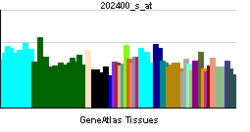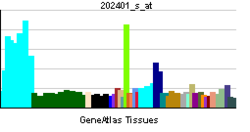Serum response factor
| SRF |
 |
|
|
| Identifiers |
| Aliases |
SRF, MCM1, serum response factor |
| External IDs |
MGI: 106658 HomoloGene: 31135 GeneCards: SRF |
| Gene ontology |
| Molecular function |
• protein dimerization activity
• transcription factor activity, sequence-specific DNA binding
• transcriptional activator activity, RNA polymerase II core promoter proximal region sequence-specific binding
• histone deacetylase binding
• transcription factor activity, RNA polymerase II core promoter sequence-specific
• transcription factor activity, RNA polymerase II transcription factor binding
• primary miRNA binding
• transcription factor binding
• RNA polymerase II core promoter proximal region sequence-specific DNA binding
• protein homodimerization activity
• serum response element binding
• chromatin binding
• protein binding
• DNA binding
• sequence-specific DNA binding
• transcriptional activator activity, RNA polymerase II transcription regulatory region sequence-specific binding
• transcription factor activity, RNA polymerase II distal enhancer sequence-specific binding
• chromatin DNA binding
• transcription factor activity, RNA polymerase II core promoter proximal region sequence-specific binding
• core promoter proximal region sequence-specific DNA binding
|
| Cellular component |
• cytoplasm
• nucleus
• nuclear chromatin
• nucleoplasm
|
| Biological process |
• dorsal aorta morphogenesis
• bronchus cartilage development
• muscle cell cellular homeostasis
• lung smooth muscle development
• regulation of water loss via skin
• transcription from RNA polymerase II promoter
• stress fiber assembly
• cell migration involved in sprouting angiogenesis
• platelet activation
• cardiac myofibril assembly
• heart looping
• cellular senescence
• face development
• regulation of cell adhesion
• long term synaptic depression
• neuron projection development
• morphogenesis of an epithelial sheet
• positive regulation of filopodium assembly
• primitive streak formation
• cellular response to glucose stimulus
• negative regulation of cell proliferation
• response to cytokine
• regulation of transcription, DNA-templated
• heart trabecula formation
• actin filament organization
• thymus development
• angiogenesis involved in wound healing
• platelet formation
• neuron development
• in utero embryonic development
• transcription, DNA-templated
• positive regulation of transcription, DNA-templated
• heart development
• positive regulation of cell differentiation
• branching involved in blood vessel morphogenesis
• positive regulation of axon extension
• positive regulation of smooth muscle contraction
• trachea cartilage development
• response to toxic substance
• positive regulation of pri-miRNA transcription from RNA polymerase II promoter
• positive regulation of transcription by glucose
• regulation of smooth muscle cell differentiation
• single organismal cell-cell adhesion
• epithelial structure maintenance
• associative learning
• skin morphogenesis
• positive regulation of sequence-specific DNA binding transcription factor activity
• epithelial cell-cell adhesion
• neuron migration
• positive regulation of transcription initiation from RNA polymerase II promoter
• eyelid development in camera-type eye
• thyroid gland development
• negative regulation of beta-amyloid clearance
• negative regulation of cell migration
• developmental growth
• hematopoietic stem cell differentiation
• gastrulation
• trophectodermal cell differentiation
• positive thymic T cell selection
• response to hormone
• cell-matrix adhesion
• sarcomere organization
• actin cytoskeleton organization
• megakaryocyte development
• response to hypoxia
• positive regulation of transcription via serum response element binding
• lung morphogenesis
• mesoderm formation
• cardiac vascular smooth muscle cell differentiation
• mRNA transcription from RNA polymerase II promoter
• multicellular organism development
• tangential migration from the subventricular zone to the olfactory bulb
• positive regulation of transcription from RNA polymerase II promoter involved in myocardial precursor cell differentiation
• long-term memory
• contractile actin filament bundle assembly
• bicellular tight junction assembly
• leukocyte differentiation
• hippocampus development
• positive regulation of transcription from RNA polymerase II promoter
• erythrocyte development
• negative regulation of pri-miRNA transcription from RNA polymerase II promoter
• forebrain development
|
| Sources:Amigo / QuickGO
|
|
|
RNA expression pattern |


|
| More reference expression data |
| Orthologs |
| Species |
Human |
Mouse |
| Entrez |
|
|
| Ensembl |
|
|
| UniProt |
|
|
| RefSeq (mRNA) |
|
|
| RefSeq (protein) |
|
|
| Location (UCSC) |
Chr 6: 43.17 – 43.18 Mb |
Chr 17: 46.55 – 46.56 Mb |
|
PubMed search |
|
|
|
|
|
1HBX, 1K6O, 1SRS
6722
20807
ENSG00000112658
ENSMUSG00000015605
P11831
Q9JM73
NM_003131
NM_001292001
NM_020493
NP_001278930
NP_003122
NP_003122.1
NP_065239.1
NP_065239
Serum response factor, also known as SRF, is a transcription factor protein.
Serum response factor is a member of the MADS (MCM1, Agamous, Deficiens, and SRF) box superfamily of transcription factors. This protein binds to the serum response element (SRE) in the promoter region of target genes. This protein regulates the activity of many immediate early genes, for example c-fos, and thereby participates in cell cycle regulation, apoptosis, cell growth, and cell differentiation. This gene is the downstream target of many pathways; for example, the mitogen-activated protein kinase pathway (MAPK) that acts through the ternary complex factors (TCFs).
...
Wikipedia



